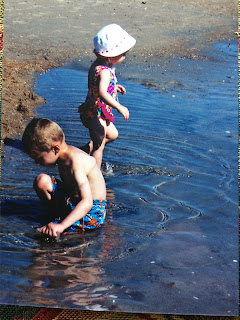I’ll
never forget the day I discovered Emil Pierson.
I
was researching Carl Pierson, my great-grandfather Herman Peterson’s uncle with
whom Herman said he was coming to stay when he immigrated from Sweden. The
Pierson family had immigrated several years earlier and were settled on a farm
in Shelby township, Bureau County, Illinois.
As I
researched Carl I came across a passport application, but the application
wasn’t for Carl, it was for his son Emil. So I looked through the document. The
information verified Carl’s immigration then went on to tell more about Emil:
permanent residence is Princeton..."where I follow the occupation of “U.S.
Army...” What?! Emil was in the army? Here's someone in our family that’s “regular army,” as they say on M*A*S*H.
 |
| Insignia for Colonel, U.S. Army |
I kept reading.
“I
am about to go abroad temporarily; and I intend to return to the United States
within 4 months…I desire a passport for use in visiting the countries
hereinafter named for the following purpose: Belgium,
England, France, Italy, Switzerland, on 'official Business' and Holland, Sweden,
and Denmark for the purpose of 'touring.' ” He planned to leave on May 5, 1921.
Well,
isn’t that something. I looked at the next page (always look at the next page!)
and there was a physical description of him with a picture at the bottom of the
page!
 |
| Emil Pierson, 1921 (U.S. Passport photo) |
Was
there more? Oh, you bet! Turn the page again and I found a typewritten letter
to Emil from J.M. Wainwright, Assistant Secretary of War.
 |
| 1921 U.S. Passport application, Emil Pierson |
More
pages followed, including permission to leave the United States, by order of
the Secretary of War and a note that verified he was appointed in the United States
Army on June 14 1907 and had been continually an officer of the Army since date
of appointment. The request for the special passport (below) noted that he would
be accompanied by his wife (!)
 |
| 1921 U.S. Passport application, Emil Pierson |
 |
| Hannah Peterson Pierson, 1921 U.S. Passport application |
Even
though Emil was not a direct descendant, he looked like he had an interesting
story. I eagerly went “down the rabbit hole” to find out more about him, and
this is what I discovered:
Emil graduated
from West Point in 1907.
He
married a Princeton girl, Hannah Peterson (no relation to me) in 1909.
He fought bandits on the Texas/Mexican border in 1916.
He was a machine
gunner instructor during World War I, or, “the World War” as it was called at the
time
He
was in charge of the settlement of claims in Europe following the World War.
He was a diplomatic
attaché in the 1930s and was presented to the Danish royal court.
In 1941 he was named head of recruiting for the army in Ohio, West Virginia, Kentucky and Indiana.
He
died in Princeton, Illinois on November 3, 1951.
The
usual documents have given me the outline of Emil’s life, but other sources
give me an insight into who this man was.
Here is his 1907 West Point yearbook entry. It sounds like he was a meticulous young man with an optimistic view of humanity in general.
 |
1907, Emil's photograph from The Howitzer,
the West Point U.S. Military Academy yearbook |
 |
1907, entry for Emil Pierson from The Howitzer,
the West Point U.S. Military Academy yearbook |
In 1933, after his time as military attache to the Scandinavian countries was finished, he spent some time in Princeton and paid a visit to his old high school. It sounds like he could probably tell a good story.
 |
Princeton Bureau County Tribune,
February 10, 1933, p4 |
In
1941 his photo appeared in numerous newspapers in Ohio, Kentucky and Indiana (including my hometown paper, The Muncie Star!) as his new recruiting duties were announced.
 |
The Muncie Sunday Star,
May 18, 1941, p1 |
Emil and Hannah never had children. They visited Princeton fairly regularly, and when they did they stayed with Hannah’s sisters
Amy and Minnie Peterson. Subsequent articles indicate that sometime in the early 1940s Emil was wounded somehow (although I don't have any indication that he served overseas in World War II). Emil died on November 3, 1951 in Princeton and Hannah died several years later on February 10, 1959.
There is still more research to be done. I have yet to find Emil and Hannah's Princeton obituaries. I want to know more about the "claims settlements" that he was in charge of after WWI. I am also curious about the last ten years of Emil's life, how he was wounded, if he retired, and if so, how he spent his last days. However, I think I've found enough so far to give a picture of the man that, until recently, I never knew resided in our family tree.
I
love Emil’s story. He came to this country from Sweden as a twelve-year-old who spoke little if any English, and he ended his days as a Colonel in the United States
Army, respected for his character and quality of work. I am proud to call him an ancestor.





















































